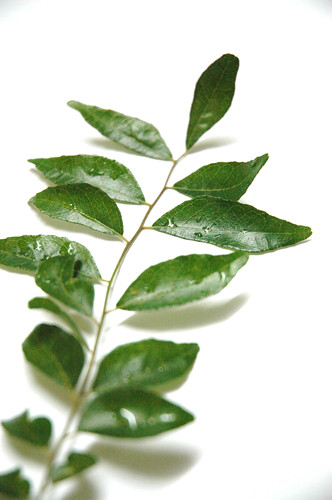 My friend Meredith asked me to write briefly about curry leaves. I'll try to expand on the Wikipedia entry a bit.
My friend Meredith asked me to write briefly about curry leaves. I'll try to expand on the Wikipedia entry a bit.First, if you're in New York and you want to know about curry leaves first-hand, go to Chola. Curry leaves are used in the cookery of my birthplace of Durban, South Africa, but they were an import there, probably brought by the earliest of the indentured servants that came as laborers from the south of the subcontinent.
The iconic curry leaf dish at Chola is the Chettinad chicken. It's chunks of chicken, with hot chillies, curry leaves, and a highly spiced tomato sauce. Absolutely breathtaking, and not too spicy for normal folks to enjoy.
From the various recipes I've cobbled together, curry leaves seem to have an affinity for tomato and spice. I've never tried them in any sort of fusion capacity, but I'd very much like to experiment a bit.
The taste is, to me, tarry and toasty, both in good ways. It's very much a warm flavor.
Enough blathering. Here's the facts:
- In New York, you can get fresh curry leaves at Dual, and at Little India. I find Little India to be a much better place to shop for actual Indian specialties than the more famous Kalustyan's on the next block. Kalustyan's is crowded and expensive, with diffident service. Little India and Dual are both friendly and helpful places with reasonable prices. If you absolutely need to buy Korean black garlic and Welsh smoked salt in the same store, go to Kalustyan's. If you are interested in cooking, though, I recommend either of these others.
- The wikipedia entry for curry leaves says you can freeze them. I have frozen them, but have never actually ended up using them, because I make a stop at one of these stores often enough that it's never come up.
- To use them, heat vegetable oil in a heavy pot with a lid. Meanwhile, rinse the sprig of leaves and shake dry. When the oil is very hot, strip the sprig into it quickly and put the lid on. The curry leaves will sputter and can burn you. When the sputtering starts to subside, go on with your recipe. This is where you can bloom some curry powder, throw in some onions, garlic, ginger, etc. The leaves will suffuse the dish with a lovely and somewhat indescribable flavor.
- Most recently, I used curry leaves and hot red chillies in a variation on the Chettinad recipe. I used whole frozen okra and tofu. It was heavenly. You could use just the okra and serve over rice for an awesome vegan curry.
- I was told by the manager at Chola that southern Indian cooking was characterized by the use of curry leaves and coconut. I wasn't clear if he meant them to be used together.
- I am sort of dying to know if they go well with seafood, particularly shrimp. I made a Madhur Jaffrey recipe the other night, shrimp with crushed black mustard seeds, that I think might work really well with curry leaves instead of mustard.
Let me know if you know anything more about this lovely seasoning.
Photo credit: ImageBang! on Flickr
